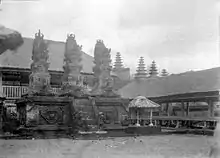Padmasana (shrine)
The padmasana (Kawi and ultimately derived from the Sanskrit term for "lotus pose" is a type of shrine in a Balinese temple. The shrine is basically shaped like an empty throne on top of a pillar. Together with the Meru towers, the padmasana is a type of shrine reserved for the most important deity in Balinese Hinduism, usually to represent the Supreme God, also known as the Sang Hyang Widhi Wasa.[1]
.jpg.webp)
History
The introduction of the padmasana shrine as an altar to the Supreme God was attributed to Dang Hyang Nirartha, the priest of the Gelgel King Batu-Renggong. Dang Hyang Nirartha is a Javanese Brahman, a poet, an architect, and a religious teacher. He arrived in Bali in 1537 at the time when Islam was spreading from the west through Java. Among his reforms in Bali was the introduction of the padmasana shrine, an altar to the Supreme God.[2][3]
Form and placement
.jpg.webp)
A padmasana has an empty throne on top, the seat of Sang Hyang Widhi Wasa. The front of the throne is usually decorated with the image of the Sang Hyang Widhi Wasa. A swan or eagle frequently decorates the back of the shrine, the swan being Brahma vehicle, the eagle is for Vishnu.[4]
Like many religious construction in Indonesia, the shrine padmasana is divided into three sections, from the base to the top, the bhur (world of demons), bhuwah (world of man), and swah (world of gods). The base of a padmasana, the bhur loka, is usually decorated with a figure of the Bedawang Nala - the world-supporting turtle, and the two snakes, Anantaboga, and Basuki - as a symbol of man's earthly needs. The center part of a padmasana, the buwah loka, usually contains decoration of man's daily activities. Near the throne, below the top, are usually decorated with various manifestations of celestial figures.[4]
A padmasana is normally positioned in the most sacred location in a temple compound, the kaja-kangin (north-east) corner. It is often placed at an angle so that the open chair faces the kelod-kauh (south-west).[4]
Samples

Pura Penataran Agung, a large temple complex dedicated to Shiva located in the Pura Besakih, contains a triple padmasana. These three padmasanas are arranged side by side, and is known together as the Padma Tiga ("three lotuses"). The Padma Tiga is located in the innermost sanctum of the temple dedicated to Shiva. Although it is often said that the three shrines are dedicated for Brahma (red), Vishnu (black) and Shiva (white),[5] actually all three are dedicated for aspects of Shiva. The red-clothed shrine on the right is dedicated Sadhashiva, the black-clothed shrine on the left is for Shiva, and the white-clothed middle shrine is dedicated to Paramashiva.[4]
The enormous and elaborate padmasana of Pura Jagatnatha in Denpasar is located directly in the center of the temple.[4]
Other Balinese temples featuring a notable padmasana are Pura Kehen in Bangli, Pura Taman Saraswati in Ubud, and Pura Taman Ayun in Mengwi.
See also
| Wikimedia Commons has media related to Padmasana (shrine). |
References
- Auger 2001, p. 26.
- Auger 2001, pp. 46-7.
- Eiseman 2011, p. 266.
- Eiseman 2011.
- Stuart-Fox 1999, p. 118.
Cited works
- Auger, Timothy, ed. (2001). Bali & Lombok. Eyewitness Travel Guides. London: Dorling Kindersley. ISBN 0751368709.CS1 maint: ref=harv (link)
- Eiseman, Fred B., Jr. (2011). Bali - Sekala & Niskala: Essays on religion, ritual, and art. Tuttle Publishing. ISBN 9781462900923.CS1 maint: ref=harv (link)
- Stuart-Fox, David (1999). Fox, James J. (ed.). Religion and Ritual: Cycles and Ritual Centres. Indonesian Heritage. Singapore: Archipelago Press. ISBN 9813018585.CS1 maint: ref=harv (link)